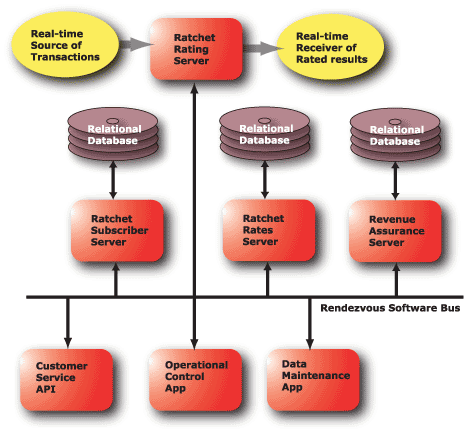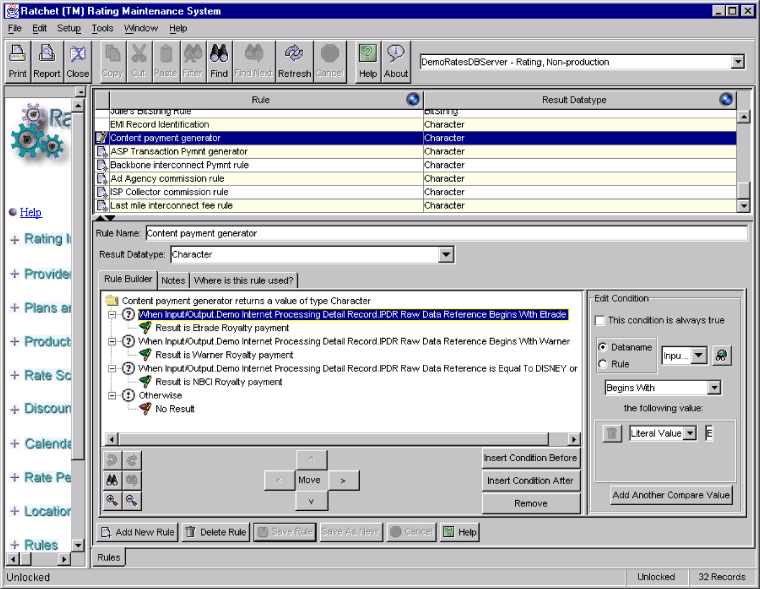Charging for content based IP services
with the Ratchet™ Rating
System
The following is a model of the opportunities for payments and charges in the content-based wireless IP services business.

Figure 1. Model of IP content-based charges
The measurement for charging
Each of these steps in the delivery of services to end-users is measured according to units of measure relevant to their performance. For example, the content provider of audio recordings is measured in either songs (cuts) or albums. The audio recording pricing model relates to the provider’s market strategy. It is unlikely that all songs cost the same amount. The ASP or Backbone Transport is paid by the amount of data transported or transactions processed. The ad agency and collector’s commissions are a percentage of the royalties or of the end-user payment. The interconnect fees are based on the amount of data transmitted. The contractual agreements between all these parties are encoded in the rules of the Ratchet Rating system.
All of these charging rules are affected by volume purchase commitments and corporate relationships. An excellent example of the impact of corporate relationships is the now merged Time Warner and AOL companies who cover all of these contribution roles for a remarkable amount of content.
Payment and Service Level Agreements
Each contributor to service delivery has its own unique service responsibilities that are expressed as a service level agreement. Failure to conform to the service level agreement reduces revenues for the contributor. For example, if the entire content of an audio recording doesn’t arrive because of the content provider’s failure, no payment will likely be made and no end-user charge appears. If the ASP or Backbone transport delays the delivery of the content, these contributors fail to meet their service level agreements and will not be paid, etc.
If a contributor’s service level agreement compliance can be determined at the time of rating, your user-defined Ratchet Rating System rules prevent un-needed payments or charges.
Contributor Charges
The amounts calculated in a content-based charging application consist of both amounts to be paid and amounts to be collected. When enough knowledge is available about all the payments and charges, you can determine the margin on an individual transaction basis.
End-user charges
This model doesn’t show the charge for the end user. The end-user may not be charged. The service provider that owns the end-user may derive its revenues from monthly fees and/or allied charges.
If the end-user is charged, there is one more segment in the diagram above for that fee calculation.
Allied Charges
An example of allied charges is the money made by American Express from active charge card customers who also get “free’” ISP services. This kind of affiliation charging can cement stronger ties to the customer while giving the provider the opportunity to further encourage use of the sponsor’s services.
The Service Contributor Chain
Content based charging has the potential of paying fees to all of the service contributors shown in the figure before.
The following page shows an example of a rule that uses the IPDR Raw Data Reference field to determine the content provider to whom a payment should be made. This rule can be made sensitive to successful service delivery by checking the value of the “IPDR Cause For Termination” field to eliminate the payment if an error prevented the delivery of all the content requested. If the cause for termination field indicates that the content provider failed to deliver, then you could report the delivery failure to the content provider and cancel any payments to service contributors and charges to end-users. The rule shown is used to generate a charge data object for which the charge is calculated. The calculation of the fee is done with a separate rating plan for the generated charge data object.
Figure 2. Ratchet Rater
panel defining the payments and charges from a content-based transaction
Click on image for
higer resolution.
Service Level LLC provides the Ratchet™ Rating system to support the needs of the content-based Internet marketplace.

Figure 3. The components of the Ratchet™ Rating System
You can learn more about the Ratchet Rating solution at http://www.servicelevel.net/. The product and its implementation support team make a success of your implementation. You can contact our representatives at mailto:sales@www.servicelevel.net
Service Level LLC
7006 Suncrest Drive
Saline, MI 48176
+1 734-827-2000 (voice)
+1 734-827-2200 (fax)
Time Zone: same as New York City


